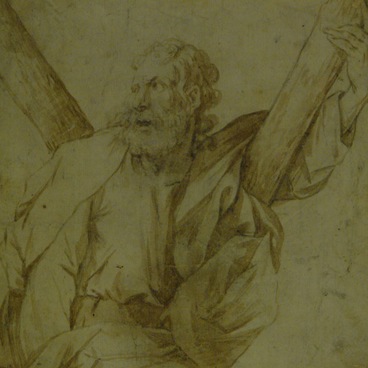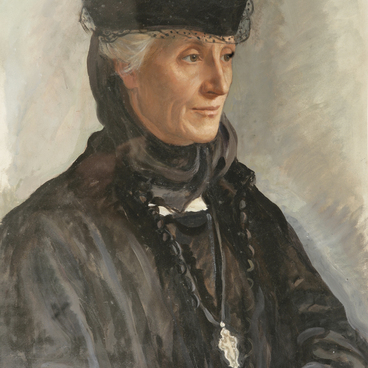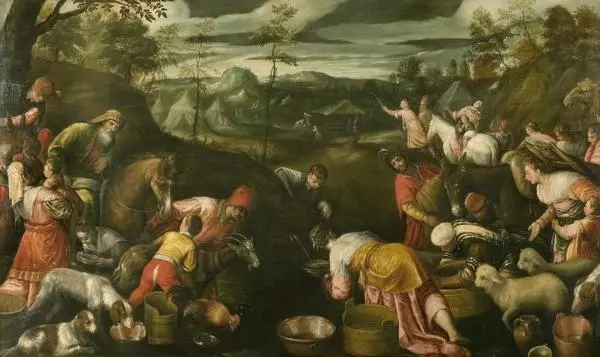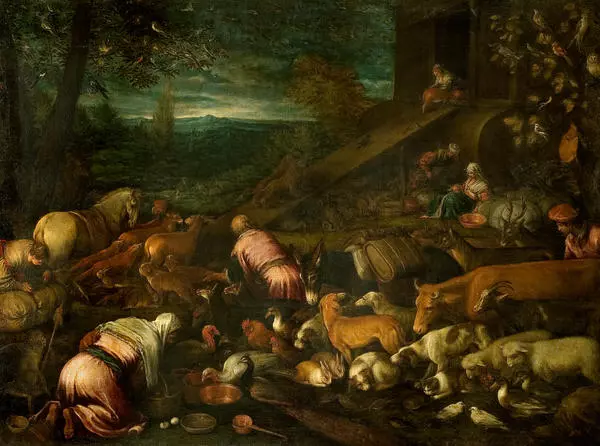The pencil drawing Christ in the house of Martha and Mary is attributed to Jacopo Bassano, an outstanding Italian painter from the late Renaissance Venetian school (about 1510 — 1592).
Jacopo Bassano, whose real name is Giacomo da Ponte, was born into the family of the Francesco Bassano Sr., a painter. He was trained by his father and later in Venice he learned from Bonifacio Veronese. In 1540, Bassano returned to his hometown. He had a big workshop there, and in 1549 he was appointed consul. Inspired by Titian, Lorenzo Lotto, Tintoretto and Mannerist artists Bassano developed his own style characterized by accuracy in the reproduction of reality and genre interpretation of religious compositions. Jacopo Bassano was one of the first Italian painters to turn to the rural theme, and it was the paintings with rural motifs that someway or other brought him fame. There are reports that the famous Paolo Veronese sent his son Carletto ‘to apprentice’ to Bassano’s workshop which shows how much he appreciated the talent of his brother in trade. Among other things, according to Bassano’s biographers, Veronese in his The wedding at Cana painted Bassano alongside himself, Titian and Tintoretto in a group of musicians. Jacopo Bassano’s paintings were very popular, and the master sometimes made replicas of the same scene with the help of Francesco, the most talented of his sons.
The drawing presented in the exposition is an interpretation of the eponymous painting by Jan Vermeer in the mirror image. Interestingly, the Gospel story is interpreted here as a scene from everyday life, depicting numerous household items. Jesus and his disciples enter Lazarus' house. Lazarus' sisters, Martha and Maria, welcome them. Martha bows down before the holy guests, and Mary invites them into the house. Lazarus sits at a table covered with white tablecloth, helping to prepare the meal. Among various household items on the table are the main symbols of the Christian religion: bread, a bowl of wine, grapes. Great attention is paid to the smallest details of life, from baskets with provisions to kitchen shelves and pets. The drawing came into the museum in 1919 from the manor of Baryatino, Tarusa County of Kaluga Governorate, as part of the private art collection of the princely family of Gorchakov.
Jacopo Bassano, whose real name is Giacomo da Ponte, was born into the family of the Francesco Bassano Sr., a painter. He was trained by his father and later in Venice he learned from Bonifacio Veronese. In 1540, Bassano returned to his hometown. He had a big workshop there, and in 1549 he was appointed consul. Inspired by Titian, Lorenzo Lotto, Tintoretto and Mannerist artists Bassano developed his own style characterized by accuracy in the reproduction of reality and genre interpretation of religious compositions. Jacopo Bassano was one of the first Italian painters to turn to the rural theme, and it was the paintings with rural motifs that someway or other brought him fame. There are reports that the famous Paolo Veronese sent his son Carletto ‘to apprentice’ to Bassano’s workshop which shows how much he appreciated the talent of his brother in trade. Among other things, according to Bassano’s biographers, Veronese in his The wedding at Cana painted Bassano alongside himself, Titian and Tintoretto in a group of musicians. Jacopo Bassano’s paintings were very popular, and the master sometimes made replicas of the same scene with the help of Francesco, the most talented of his sons.
The drawing presented in the exposition is an interpretation of the eponymous painting by Jan Vermeer in the mirror image. Interestingly, the Gospel story is interpreted here as a scene from everyday life, depicting numerous household items. Jesus and his disciples enter Lazarus' house. Lazarus' sisters, Martha and Maria, welcome them. Martha bows down before the holy guests, and Mary invites them into the house. Lazarus sits at a table covered with white tablecloth, helping to prepare the meal. Among various household items on the table are the main symbols of the Christian religion: bread, a bowl of wine, grapes. Great attention is paid to the smallest details of life, from baskets with provisions to kitchen shelves and pets. The drawing came into the museum in 1919 from the manor of Baryatino, Tarusa County of Kaluga Governorate, as part of the private art collection of the princely family of Gorchakov.






